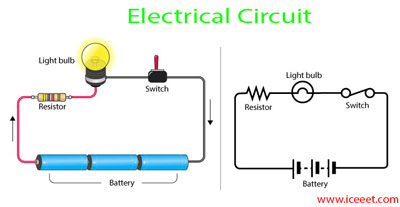You may be wondering how charges can continuously flow in an electrical circuit in a uniform direction through wires without the benefit of these hypothetical Sources and Destinations. In order for the Source-and-Destination plan to work, both would have to have an infinite capacity for charges in order to maintain a continuous flow.
Table of Contents
What is Electrical Circuit?
The circuit is a close loop or path where electron flows or tend to flows
An Electric circuit is an interconnection of several elements in which there is at least one closed path in which current can flow. Circuits generally consist of electrical components connected with wires. The wires and other parts of a circuit are normally made of metals, such as copper or aluminum, which are good conductors of electricity.
Electrical Circuit Elements
An Electric circuit consists of the following types of elements.
Active elements
Active elements are the elements of a circuit that possess energy of their own and can impart it to other elements of the circuit.
Active elements are of two types
a) Voltage source b) Current source
a) Voltage source
A Voltage source has a specific voltage across its terminals, independent of current flowing through
it.
b) Current source
A current source has a specific current through it independent of the voltage appearing across it.
Passive Elements
The passive elements of an electric circuit do not possess the energy of their own. They receive energy from the sources.
Passive elements are of three types
a) Resistor b) Inductor c) Capacitor
a) Resistor
If the energy is consumed, then the circuit element is a pure resistor.
b) Inductor
If the energy is stored in a magnetic field, the element is a pure inductor.
c) Capacitor
And if the energy is stored in an electric field, the element is a pure capacitor.
Types Of Sources In Circuit
There are two types of sources
a) Independent sources.
b) Dependent sources.
Independent sources
If the voltage of the voltage source is a completely independent source of current and the current of the current source is completely independent of the voltage, then the sources are called independent sources.
Dependent sources.
The special kind of sources in which the source voltage or current depends on some other elements in the circuit which may be either a voltage or a current anywhere in the circuit are called Dependent or Controlled sources.
There are four Dependent sources:
a) Voltage-dependent Voltage source.
b) Current dependent Current source.
c) Voltage-dependent Current source.
d) Current dependent Current source.

Independent sources actually remain as physical entities such as the battery, a dc generator & an alternator. But dependent sources are used to represent the electrical properties of electronic devices such as OPAMPS & Transistors.
Circuit Analysis
Circuit analysis means figuring out voltages and currents in each element. Here’s an overview of circuit analysis, with some context for the various formula and methods we use to analyze circuits.
- Star to Delta and Delta to Star Transformations
- Mesh Analysis and Super Mesh for DC excitation
- Nodal Analysis and Super Node for DC excitation
- KCL (Kirchoff Current Law)
- KVL (Kirchoff Voltage Law)
Network Theorem
There are some theorems that can be applied to find the solution of electrical networks by simplifying the network itself or it can be used to calculate their analytical solution easily. The electrical circuit theorems can also be applied to A.C systems, with only one distinction: replacing the ohmic resistance of the D.C system with impedance.
These are the network theorems
- Thevenin’s Theorem
- Norton’s Theorem
- Maximum Power Transfer Theorem
- Superposition Theorem
Owner Of ICEEET





1 comment
hey there and thank you for your information – I have
certainly picked up anything new from right here. I did however expertise
some technical points using this website, as I experienced to reload the web site lots of times previous to I could get it to load correctly.
I had been wondering if your web hosting is OK? Not
that I am complaining, but sluggish loading instances times will very frequently affect your
placement in google and could damage your quality score if ads
and marketing with Adwords. Anyway I am adding this RSS to my email and
can look out for much more of your respective intriguing content.
Ensure that you update this again soon.